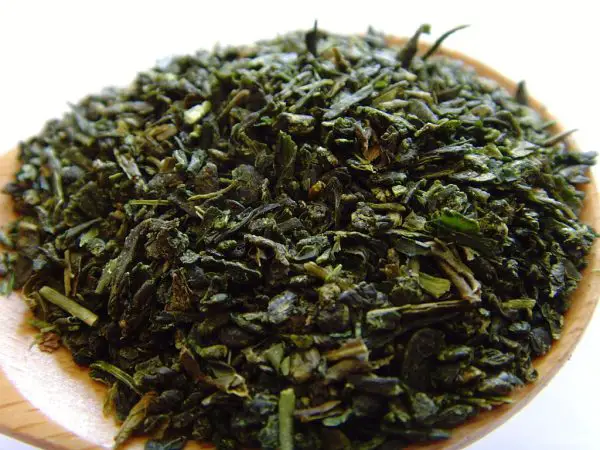Mecha is a popular type of Japanese green tea. Mecha consists of early leaf buds harvested in the spring. It is considered the by-product of Gyokuro and Sencha tea leaves that processors separate from the whole leaves during processing. This processing method makes it a cheaper alternative for those that want to enjoy high-quality green tea.
“Me” means bud, and “cha” comes from the Japanese word for tea, “ocha,” so mecha translates as “bud tea.” In Japan, “jinko” is another term for mecha, which means “incense” or “perfume.” A reference to mecha’s unique aromatic scent.
The world of Japanese green tea involves precise harvesting and processing methods to extract the most delicate flavors from tea leaves at every stage of life.
Mecha is a delicious and nutritious tea that can help improve overall wellness and give you a little caffeine boost without the crash that coffee can have.
How does Mecha Tea Taste?
Mecha is a bitter tea known for its sharp taste. The nutrients found in mecha create a powerful astringency, which is a drying sensation in the mouth. Mecha also contains a rich umami flavor with a bitter aftertaste.
This depth of flavor makes it a popular choice as a palate cleanser after meals.
The intense umami flavor comes from the young leaves on the bud. This lends an earthiness to mecha tea that pairs well with the bitter aftertaste. Like most green teas, there are hints of delicate florals and grassiness.
How is Mecha Tea Processed?
Like all tea, Mecha comes from the Camellia sinensis plant. Mecha is technically the discards of tiny buds separated during the processing of gyokuro and high-grade sencha. This processing method makes it a high-quality but cheap alternative to sencha and gyokuro.
Tea producers gather the leaves during the first or second harvest of the season. These early harvests catch the leaves at their highest concentration of nutrients, which create the most intense flavor profiles that make high-quality Japanese tea so renowned.
Like other high-quality green teas, mecha tea goes through steaming, rolling, and drying after harvest to enhance the natural flavors. After drying, the processors roast the tea. Tea particles are separated by size into about five groups for the most even roasting.
The primary groups contain whole leaves, known as “Honcha” and “Shiagecha,” which become Sencha or Gyokuro. The by-products of this process, categorized as “Demono,” create Konacha (the twigs), Kukicha (the powder), and Mecha (the buds) tea.
Mecha tea leaves are rolled into small lumps rather than the more common needle shape of high-quality Japanese green teas. They adopt this shape naturally during steaming and drying due to their smaller size and higher water content.
How to Brew Mecha Tea?
Most high-quality Japanese green tea demands a bit more attention in the preparation process than the average tea. Mecha, however, is one of the most delicate of the green teas due to its already sharp and intense flavor. Therefore, the brewing process of Mecha tea must be as precise as possible to avoid bitterness.
On the other hand, an advantage of mecha tea is its capability for multiple infusions. As a result, mecha can be steeped countless times without losing flavor compared to the standard two or three infusions of other high-quality green teas.
The brewing process varies slightly depending on the quality of Mecha tea. Start with 4g of Mecha tea, or roughly two teaspoons, and 160ml or 5.4oz of water.
For standard grade Mecha, bring the water to a boil at 100 degrees Celsius, or 212 degrees Fahrenheit, and brew for 40 seconds. For high-grade Mecha tea, bring the water up to 70 degrees Celsius, or 158 degrees Fahrenheit, and boil for 60 seconds.
Remember that Mecha tea has an intense flavor. Brewing for more than 60 seconds will likely make the tea bitter and unpleasant. Keep the tea leaves and brew as many pots as you like throughout the day. Just remember to keep them within 24 hours to avoid bacteria growth.
Nutrition of Mecha Tea
Like all green tea, Mecha tea has strong antioxidant and anti-inflammatory properties that boost the immune system. In addition, Japanese green tea’s rich vitamins and minerals also help prevent cancer, reduce the risk of heart disease, improve oral health, encourage weight loss, and help clear skin.
It contains notably high levels of catechin, caffeine, and L-theanine.
Catechin is a well-known and powerful antioxidant that can boost your immune system and help you recover from colds.
Caffeine is a metabolism booster, while the L-theanine helps create a slow release of caffeine so you won’t suffer from any intense spikes and drops in energy and can stay free from jitters. These two working in conjunction allow for better brain function.
The high levels of catechin and caffeine are the primary contributors to the bitter flavor.
Most Japanese green teas contain roughly 28mg of caffeine in comparison to the 96mg found in coffee. The highest amount of caffeine in green tea is matcha, at 70mg. This increased level is because matcha is powdered green tea that dissolves totally and allows for total nutrient absorption, whereas loose-leaf tea and bagged tea lose some of the nutrients in the brewing process.
Summary
Mecha tea is a delicious and nutritious green tea that’s a perfect starting point for those exploring high-quality Japanese green tea. As a by-product of the more renowned Gyokuro or Sencha, it still has much of that high-quality flavor but comes at a much lower price.
Mecha is known mainly for its intense umami flavor with a noticeable bitter aftertaste, making it a popular palette cleanser. In addition, it’s full of powerful vitamins and nutrients and contains high levels of antioxidant catechin, which contributes to the bitter flavor.
Attributions
Featured Image: FCartegnie, CC BY-SA 3.0 https://creativecommons.org/licenses/by-sa/3.0, via Wikimedia Commons

